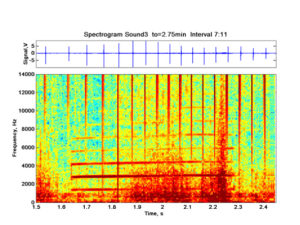Data Processing of Narwhal Tooth Expedition
Collaborators: Martin T. Nweeia, Expedition Leader and Principle Investigator, Andrey K. Morozov, Galina P. Morozova
Expedition Harvard University, 2004 Expedition Campsite 72 degrees 27 minutes 07.7 sec. N 80 degrees 56 minutes 27.0 sec. W.
Objectives: The tusk was examined as a sensory organ based on observations. First, sound and vibration transmission in the tusk have been noted (Best, 1972). Second, the unique tusk emergence angle, pointing downward and outward from the whale's longitudinal axis suggests possible sensory function. Third, because of the unusual tusk helix, dentinal crystal patterns formed during development may contribute to a Piezo effect (Bassett and Becker, 1962; Kay et al., 1964; Freeman, 1966; Shamos and Levine 1967).
Three experiments were prepared for field research. The first was the attachment of a tusk sensor, a small electronic unit housed in a casing roughly 1" by 1" by 2". Information gathered was transferred by wireless communication to a logging unit attached to the body of the whale. The logging unit was retrieved after several hours and one logging unit was successfully retrieved. Mat Laibowitz at MIT's Media Lab under Dr. Joseph Paradiso designed and fabricated the electronic boards for the sensor and logging unit. The second study included recording narwhal vocalizations during captivity. An array of two hydrophones was placed a few inches from the tip of the tusk in males and roughly one meter in front of females. The hydrophones were placed in a vertical plane in line with the sound producing area of the melon and in the area of the tusk. Two males and two females were recorded.
Funding Agencies

National Science Foundation (NSF), Harvard School of Dental Medicine, Museum of Comparative Zoology at Harvard, Smithsonian Institution, Explorers Club, Castle Harlan, NSERC, Fisheries and Oceans Canada, and the Nunavut Wildlife Management Board.
